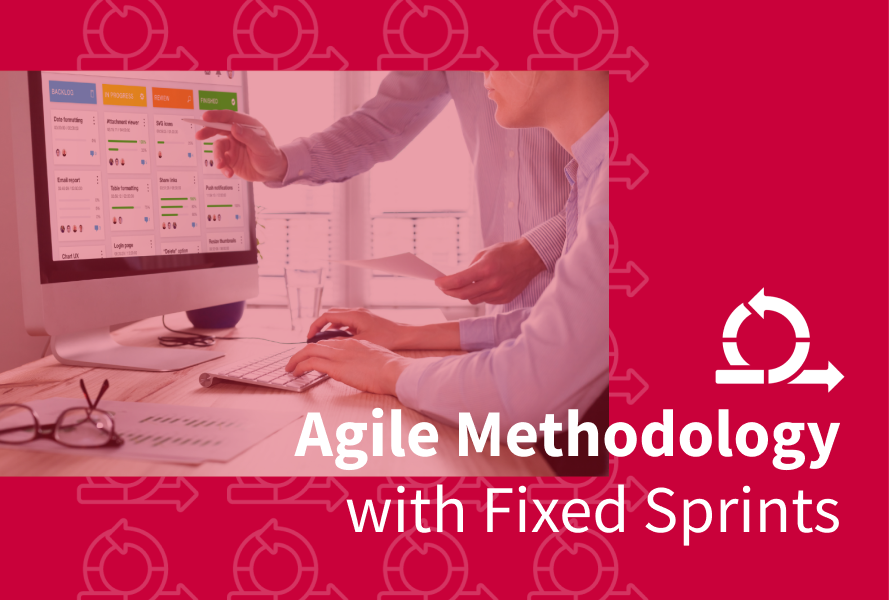Ideation
Define the challenge
We work with IT companies a lot, and many of those big IT and software companies promise everything and it ends up being a disaster in the end. I have never had that experience with Yameo as they always deliver on what they promise, and it is always for good money.

In the dynamic world of software development, agility is the name of the game. At Yameo, we have embraced the agile methodology with fixed sprints as a cornerstone of our development process. This approach allows us to deliver high-quality software, maintain transparency, and collaborate effectively with our customers. In this article, we will take a sneak peek behind the curtain on how we perform agile methodology with fixed sprints to create successful software projects.

Firstly, let’s briefly clarify what agile methodology with fixed sprints is:
Agile methodology: Agile is a flexible approach to software development that emphasizes collaboration, customer feedback, and incremental progress. It allows for the adaptation of project requirements and priorities as they evolve during a project. In essence, it is breaking down a project into smaller pieces, and then planning tasks for completion of those pieces whilst allowing for testing and feedback.
Fixed sprints: Sprints are time-boxed development cycles, typically lasting two to four weeks. During each sprint, the development team focuses on completing a set of predefined tasks, features, or user stories. It means that the project manager needs to accurately plan out sprints to ensure continuous development.
Every successful project starts with a comprehensive kick-off and discovery phase. During this phase, we work closely with our clients to gather requirements, identify goals, and define the scope of work. This step is crucial for setting the foundation for the upcoming sprints. You can find more info about the discovery phase in our article Why a Discovery Workshop is so important for a Software Project?.
After the Project Plan, scope, timelines, etc. have been approved, we often hold kick-off sessions with our customers to go through the project once more and to officially start the development.
Once we have a clear understanding of the project’s scope, we dive into sprint planning. This involves breaking down the project into manageable pieces, prioritizing features or user stories, and estimating the effort required for each task. Our team, along with some customer input, collaboratively decide what will be tackled in the upcoming sprint.
With the sprint plan in place, the development team gets to work. Daily stand-up meetings are held to ensure everyone is aligned on progress and that any bottleneck situations are properly addressed.
Our clients are an integral part of the agile process. We maintain open channels of communication, providing regular updates and/or demos of the work completed during the sprint. This transparency allows clients to see the software’s progress and make informed decisions. Our project managers are in this case the focal point of communication.
Check our article How to monitor software projects’ progress if you want to learn more about keeping your project on track.
At the end of each sprint, we conduct a short review meeting with the customer to demonstrate the sprint’s deliverables. This is an opportunity for feedback and validation. We also hold a retrospective meeting with our team to identify what went well and what could be improved in the next sprint. Moreover, we hold monthly meetings with developers, the project manager, and our business development employees to showcase the developments and provide any fresh perspectives.
Agile is all about adaptability. If changes or new requirements emerge during the project, we assess their impact on the overall timeline and budget. Together with the customer, we make informed decisions about whether to incorporate these changes in the upcoming sprint or plan for them in a future iteration.
Quality is a top priority in every sprint. We conduct rigorous testing and quality assurance activities to ensure that the software meets the defined requirements and is free of critical defects. This proactive approach minimizes the need for post-development bug fixing.
Agile encourages a culture of continuous improvement. After each project, we conduct a thorough retrospective to evaluate our process and identify areas for enhancement. This iterative improvement cycle helps us refine our agile practices and deliver even better results in future projects.
Define the challenge
Produce
solutions
Design and build
Launch and test
release
Hosting and SLA
Consultations
By implementing an agile methodology with fixed sprints, Yameo has achieved a balance between flexibility and structure. This approach allows us to adapt to changing requirements, maintain transparency with customers, and consistently deliver high-quality software. It’s not just about completing tasks; it’s about building strong partnerships, fostering collaboration, and ensuring the success of every software development project we undertake. Agile with fixed sprints isn’t just a methodology for us—it’s a mindset that drives our commitment to excellence.
Take a deeper look into our case studies and witness agile in action
Explore Our Case StudiesI have been at Yameo since 2016 working closely with the customer in understanding their needs and delivery successful projects. My background is in International Business Management with a key eye on Sales and Marketing. I have a big interest in video solutions and so I'm also involved in Yameo's video-oriented projects.
Get monthly business and technology insights straight to your inbox.
We welcome your recommendations. As a thank you, for every successful referral, we’ll award you based on your friend level of expertise.
Want to embark on an adventure with Yameo? Whether you’re an experienced developer or you’re just taking your first steps in programming, we’ll be happy to help you grow and learn in our company.
